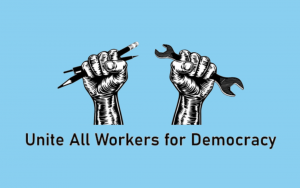Proponents of capitalism argue that without the profit motive, scientists and scientific companies will have no incentive to innovate. In The Tragedy of American Science, Clifford D. Conner shows how, in industry after industry, the opposite is true: capitalism is stifling the potential of science, corrupting its integrity, and turning research toward only what will be profitable, not what will help humanity.
The book is divided into four sections. In “The Corporatization of American Science,” Conner presents ten chapters, each charting the capitalist-fueled corruption of a different industry. The second section, “The Militarization of American Science,” contains eight chapters, each about a different military technology and the political economy of its development. In the last two sections, “How We Got Into This Mess…” and “…And The Only Way Out,” Conner describes three periods of American scientific history, outlines his transitional demands for science, and includes one epilogue addressing Covid-19, which emerged during the late stages of the book’s publication cycle.
Due to the big-picture nature of the book, Conner isn’t able to go into great detail in any given chapter, but each one is packed full of examples of how the noble ideals of science have been compromised from the very beginning in every single industry. And although he is writing during the Trump administration, which would have been easy pickings, Conner spares no one — not Obama, not even Bernie Sanders. In fact, a recurring theme is that Bush did something bad, Obama made it worse under the cover of Democratic respectability, and Trump continued his work (without any respectability).
The two parts that I found most edifying were the section on how the U.S. economy cannot function without massive military spending, which I summarized in this article, and Conner’s brief overview of scientific development in the Soviet Union, China, and Cuba. He is careful to label each of these countries as “post-capitalist” rather than “socialist.”
“The distinction is crucial,” he writes, “Fully developed socialism requires a high level of economic development and democratic control of production and political life. Both [the Soviet Union and China] started out ‘on the road to socialism’ but unfortunately got bogged down and eventually turned back.”
On the Soviet Union, he writes that while the Bolsheviks were very enthusiastic about scientific development, “Efforts to promote research were severely hampered not only by the war-ravaged country’s shortage of material resources but also by a deficiency of scientific talent.” Many anti-Bolshevik scientists had left the country, while most of the rest were “unsympathetic to the Bolshevik regime” (p.270). Lenin thought it would be unwise to forcibly conscript them into working for the Bolsheviks, so he largely left them alone, and later Stalinist purges “paralyzed” scientific education and research in the country until Stalin was able to consolidate his power. Conner concludes: “In spite of [the Soviet Union’s] success in accomplishing impressive large-scale technological feats — hydroelectric power plants, nuclear weapons, earth-orbiting satellites, and the like — the achievements of the Soviet science establishment fell well short of its potential” (p.271) due to Stalinist censorship of findings that did not serve his regime and control over what research could be done in the first place. In China, he explains, it was a similar story: the influence of the Soviet Union’s style of research plus pressure to try to keep up with the United States and the Soviets meant most research “focused on military and big industrial projects at the expense of research aimed at improving the lives of the billion-plus people of China” (p.272).
Conner also takes time to explain while the situation in Cuba developed differently, and it’s his discussion of Cuba’s medical industry that feels most relevant in the present moment. Cuba is likely to become the smallest and first Latin American country to develop its own Covid-19 vaccine. As Left Voice’s own Scott Cooper explains, Cuba has one of the most efficient healthcare systems in the world and regularly sends thousands of doctors overseas to assist in medical crises, such as the Chernobyl disaster, the Ebola epidemic, and the early outbreak of Covid-19 in Italy. It is anticipated that once Cuba has vaccinated its own population, they will likely sell their vaccine at cost to other less wealthy nations, which are struggling to get vaccines when wealthier countries are buying up all available doses.
According to Conner, Cuba’s small population meant they could not hope to compete with larger countries on the military scene. After the Cuban Revolution, the newly formed workers’ state decided to invest in non-military scientific pursuits for the good of the people instead. Investing in scientific development meant investing in education, so a mass literacy campaign successfully brought Cuban national literacy rates up from about 60% in 1960 to to 99.8 percent, one of the highest literacy rates in the world. The United States’ embargo on Cuba forced the country to develop its own medicines and other technologies, and now Cuba “stands at the forefront of international biochemical and pharmacological research” (p.274). Conner says Cuba is too small and its success too industry-specific to be able to extrapolate firm conclusions from its example, but “its achievements in the medical sciences certainly provide hope for the rest of the world.”
Conner is clear that “electing politicians who call themselves socialists” is not enough, and he offers the following demands as “starters” for liberating science and paving the way toward “creating economic democracy, which will require a monumental struggle to abolish private ownership of the country’s industrial base and other productive resources” (p.277):
- Nationalizing the pharmaceutical industry
- Nationalizing the energy-production industries
- Nationalizing the banks and insurance companies
- Nationalizing the industries currently used to create military technologies and repurpose them toward activities that actually benefit humanity
Most crucial to achieving this, he says, is the resurrection of a powerful American labor movement that will unite the various protest movements and use their power as workers to demand the necessary changes.
The Tragedy of American Science has relatively little explicitly socialist content until the very end, but it’s a valuable and comprehensive resource for information about not only how capitalism has shaped the development of scientific inquiry in general but how this influence plays out specifically across several key industries. Technocratic utopian fantasies of solving the world’s problems with science are perhaps possible, but Conner makes a highly persuasive case for why they are not possible in a capitalist economy.











